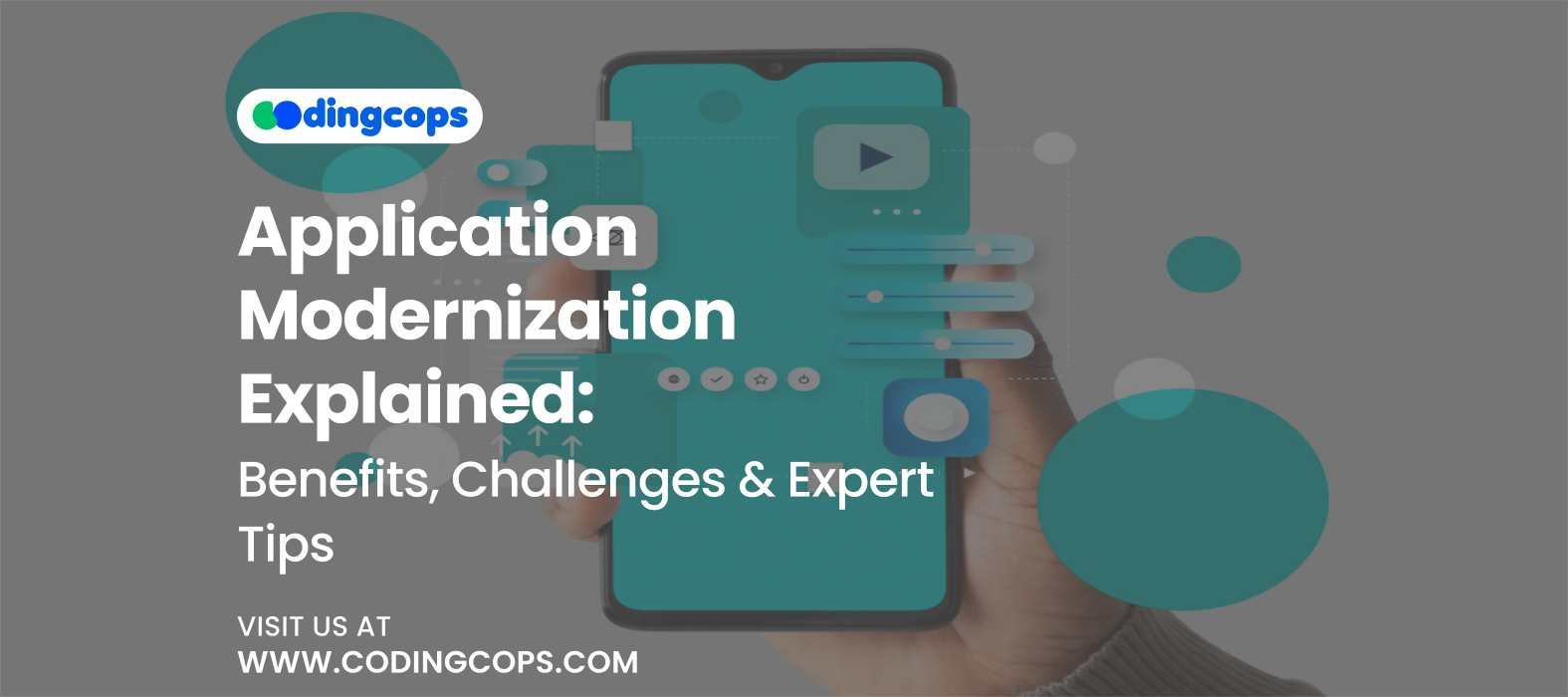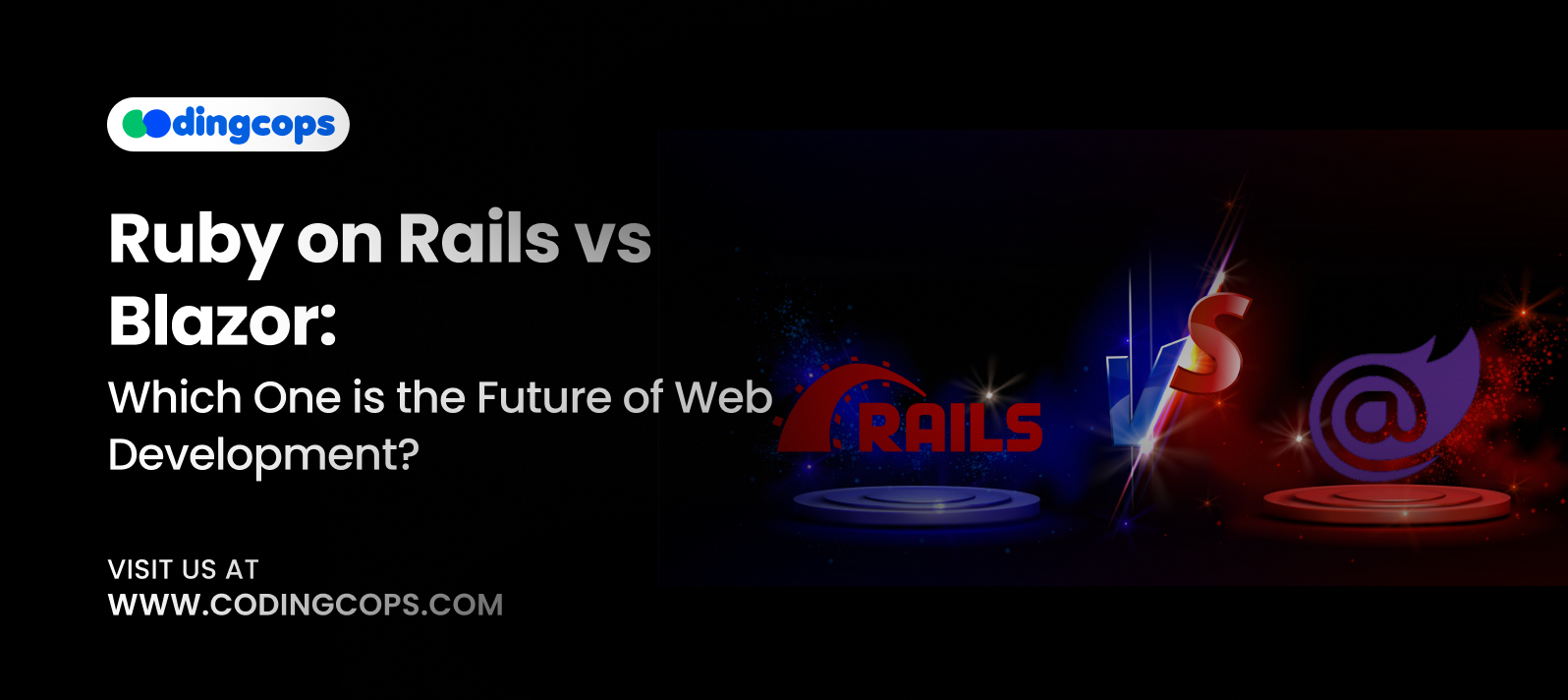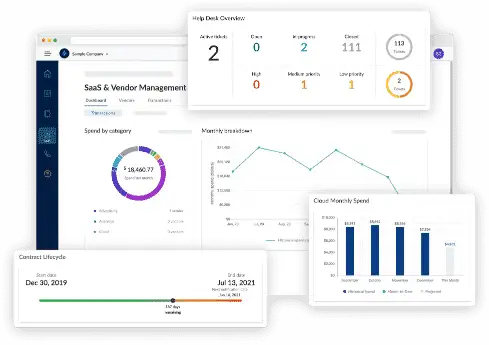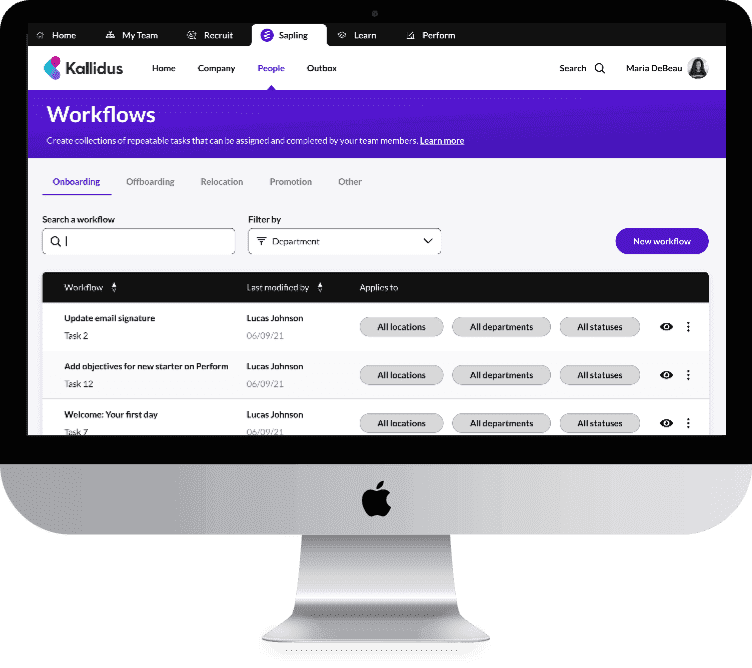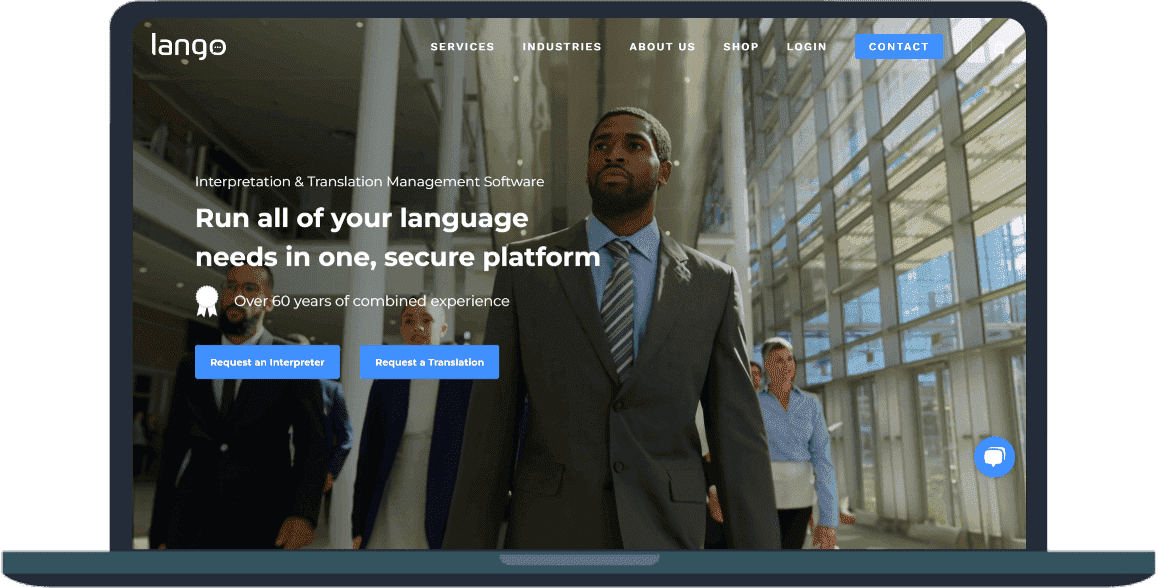According to PR Newswire, the market for application modernization will grow to $50,400 million in the next three years. Therefore, developing dynamic apps has become critical. However, many organizations still use old software. These systems often hold critical business data and processes. But they can also be incompatible with modern tools and practices.
So, application modernization becomes extremely important. It’s the process of updating legacy applications to modern technologies and infrastructure.
So, in this blog, we will explore what application modernization is and what benefits it brings. Moreover, we will discuss the common challenges development teams face when modernizing apps.
What is Application Modernization?
Application modernization is the process of updating and modifying outdated software systems to meet current business practices and technology specifications. It also enables companies to take advantage of the most recent advancements, such cloud computing and microservices.
Furthermore, modernization enhances these apps so they can work better. Also, they can integrate better with existing systems. Hence, the goal of application modernization is to future proof applications and easier to maintain in the long run.
Approaches to Application Modernization

Rehosting
Rehosting involves moving an application from its existing environment to the cloud with minimal changes to the codebase. Also, this approach is primarily focused on the infrastructure. This makes it possible for companies to swiftly move from outdated data centers to cloud environments such as AWS. It is therefore a well liked choice for businesses trying to save on hardware expenses. Additionally, companies may swiftly switch to new systems without interfering with their current processes. Rehosting is a low risk solution, but it doesn’t fully take advantage of cloud native capabilities like auto scaling.
Replatforming
Replatforming takes rehosting a step further by making minor changes to the application so it can better perform in a modern environment. Moreover, this could involve switching the database engine or reconfiguring infrastructure to optimize cloud performance. The architecture of the program stays the same, but it becomes more scalable. Replatforming is also perfect for companies that wish to optimize to some degree without incurring the costs or difficulty of a complete rewrite or restructure.
Refactoring
The goal of refactoring is to enhance an application’s internal code organization without altering its outward behavior. This method is also frequently used to improve speed and deal with technical debt. Refactoring in the context of modernization may entail dividing a monolithic application into modular parts, which may lead to the development of a microservices architecture. It’s also particularly helpful when the company still benefits from the current application logic, but it has performance problems and deployment inefficiencies.
Rearchitecting
Rearchitecting, which involves redesigning the application’s architecture to fully use modern technology or fit new business demands, is a more thorough approach. A serverless framework may need to be implemented, or large systems may need to be divided into a number of loosely connected microservices. Furthermore, rearchitecting helps companies to build highly scalable systems that enhance modern DevOps techniques.
Rebuilding
Rebuilding means rebuilding the application from scratch using contemporary programming languages. Additionally, this approach is typically used when the business’s needs cannot be met by the old system. Rebuilding also provides a new beginning and links to modern ecosystems. But in terms of expenses and possible interruptions, it also presents the greatest challenges.
Replacing
Replacing is the process of retiring the legacy applications entirely and substituting them with a modern solution or SaaS platform. When an existing software product may better serve the needs of the company than maintaining or updating the present system, this strategy can work. Although replacing eliminates the requirement for bespoke development, internal procedures or processes may need to be adjusted to accommodate the new tool’s features.
Why Businesses Need to Modernize Applications?

Rising Maintenance Costs of Legacy Systems
Usually, obsolete hardware and programming languages are used to construct legacy systems. The expense of upkeep rises dramatically as this software ages. Because of this, it is getting harder and more expensive to find qualified experts who can deal with old codebases. Due to their poor use of resources, older systems may also need more manual interventions and have greater operational expenses.
Inability to Scale with Business Growth
The dynamic scaling demands of contemporary companies are too much for legacy systems to manage. Older programs frequently find it difficult to keep up with the growing amounts of data and customer demands. Additionally, they may require expensive hardware modifications to scale or crash under heavy loads. Thus, companies may achieve elastic scalability by upgrading their systems, particularly with cloud solutions. Hence, this ensures their systems automatically adapt to fluctuating workloads without performance degradation.
Security Vulnerabilities
Cybersecurity threats can change extremely quickly. Therefore, legacy applications are among the most vulnerable. Also, outdated systems often lack support for modern security protocols. Additionally, they aren’t updated frequently, and they might not be up to current with industry standards anymore. Additionally, updating software enables companies to put in place dependable security measures and guarantee continuous adherence to legal requirements.
Poor User Experience
Slow and cumbersome response times are common in legacy applications. Users may become irate as a result, which might diminish engagement and lower customer satisfaction. Also, modern applications provide mobile first designs and user centric features that meet the expectations of modern consumers.
Lack of Integration
Modern digital ecosystems are built around seamless integration. Therefore, businesses use a range of tools like cloud services. These tools interact with core applications. Furthermore, legacy systems often lack APIs. This makes integration with modern platforms difficult or impossible without complex workarounds. Moreover, modernization enables easier data sharing and faster onboarding of new tools and technologies.
Barriers to Innovation
The way legacy systems hinder innovation is one of their main disadvantages. As a result, out of date software restricts the capacity to test new features. On the other hand, cloud automation and agile development are supported by contemporary apps. As a result, companies are able to develop more swiftly and provide new goods or upgrades sooner.
Better Use of Data Analytics
Sometimes, legacy systems store data in silos. Also, they don’t support modern analytics tools. Hence, businesses struggle to make decisions based on data. Updated apps now have features like machine learning and can easily communicate with modern analytics platforms.
Developer Efficiency
Outdated software not only frustrates customers but also slows down internal teams. Moreover, developers working on legacy applications face long development cycles and limited tooling support. Modern development environments and automation are also introduced by updating apps, which boosts output and lowers burnout.
Sustainability
The infrastructure of today is more sustainable. Additionally, companies can modify their systems to operate more effectively if they want to lower their carbon impact. This uses fewer resources and performs better as a consequence.
Issues in Application Modernization
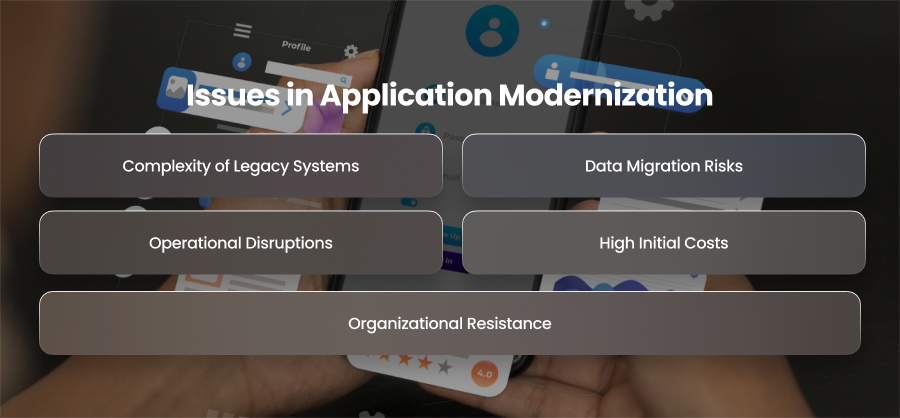
Complexity of Legacy Systems
Legacy applications are often large and monolithic. Moreover, they have been modified with code that is sometimes undocumented. Therefore, these systems aren’t built with modern design principles in mind. This makes it difficult to isolate components or implement changes without impacting the entire application. Also, business logic may be buried in hard coded functions, and dependencies on obsolete frameworks or custom built middleware can complicate refactoring efforts.
Data Migration Risks
Moving data from old systems to new platforms is one of the most sensitive parts of upgrading. Additionally, old data may be kept in unstructured databases and out of date formats. Redundancies and inconsistencies may have developed over time; if left unchecked, they may cause integrity problems.
The requirement to handle sensitive data in accordance with regulatory requirements adds another degree of risk. Inadequate data transfer can also lead to regulatory issues and the loss of important data.
Operational Disruptions
Modernization projects disrupt business continuity if not carefully executed. Many legacy systems support business functions. Downtime can result from bringing them offline for migrations or updates. Furthermore, even brief outages can have serious negative effects on a company’s finances in sectors like banking. Organizations run the danger of creating volatility in their operations if they don’t implement tactics like phased rollouts.
High Initial Costs
Altough modernization typically leads to cost saving over time, the upfront investment can be considerable. Moreover, expenses can include cloud subscriptions and new software licenses. In some cases, hidden costs emerge mid projects, such as the need for unplanned infrastructure upgrades or custom integrations.
Organizational Resistance
Modernizing an application involves more than simply changing the code; it also entails changing how the company functions. Furthermore, there is frequently internal opposition to these changes. While engineers may be reluctant to abandon tools they have been using for years, employees may be cautious of new systems that change their processes. Additionally, managers may be hesitant to interfere with functioning systems. Moreover, this reluctance may lead to poor acceptance and delays in the absence of a defined change management plan.
Tips for Application Modernization
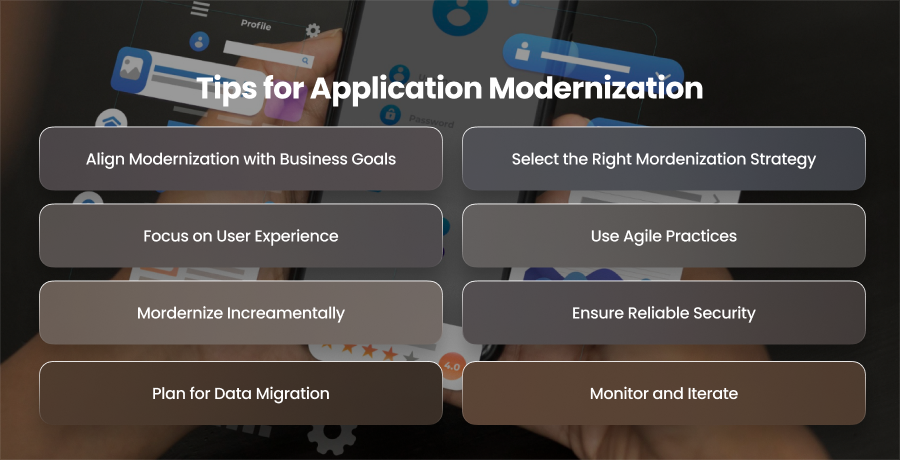
Align Modernization with Business Goals
Modernization shouldn’t be only driven by technological trends. It must thus align with the company’s larger objectives, including enhancing the customer experience. As a result, you should ensure that software developers and leadership have a common understanding of what success looks like.
Select the Right Mordenization Strategy
There’s no one size fits all approach to modernization. Consequently, you ought to decide to fully rebuild a few mission critical systems and rehost some apps. The secret is to adapt the approach to the particular requirements of every application.
Focus on User Experience
Your modernization initiatives should be focused on your end consumers. Additionally, upgrading might be a chance to reconsider and revamp the user experience. As a result, you may decrease downtime and implement responsive design. A modern system with outdated functionality or poor performance won’t meet expectations.
Use Agile Practices
The expectations of current application delivery are too great for traditional waterfall models to meet. Instead, you should use agile development methods to accelerate release cycles and foster cooperation. Additionally, development pipelines should be implemented to automate testing and deployment and enable rapid iterations. Additionally, consistency between environments may be further enhanced by Infrastructure as Code.
Mordernize Increamentally
It might be daunting and dangerous to try to update your entire application in one go. You should instead adopt a step by step strategy. You can begin with low risk applications or non critical components to build momentums and demonstrate early wins. Gradually modernize modules and use techniques like microservices decomposition or phased rollouts.
Ensure Reliable Security
Security should be included into all aspects of the modernization process. Vulnerabilities in legacy systems must frequently be fixed during the upgrade. Therefore, by including security testing into your development pipelines, you should embrace a DevSecOps approach. Also, you can use modern architecture mechanisms and role based access control. Also, be vigilant about security in cloud configurations, misconfigured storage or permissions are common causes of breaches.
Plan for Data Migration
Data migration is one of the most complex parts of modernization and requires thorough preparation. Additionally, you should develop mapping techniques for the new contexts and comprehend your data structures. You should also decide whether your use case is better served by a complete or phased migration. Always confirm data integrity and test migrations in staging environments prior to going live.
Monitor and Iterate
Deployment is only the beginning of modernization. You should keep a careful eye on a modernized application once it is live to make sure everything works as it should. To find problems early, you may employ performance monitoring tools and real time analytics. To find areas that need improvement, you may also collect customer input. The application should then be regularly optimized in accordance with usage trends and business requirements.
Final Words
Retaining competitiveness requires modernizing applications. Therefore, by using contemporary technology and getting rid of outdated limitations, you may enhance application performance. Additionally, you may future proof your apps with proper planning and implementation.

